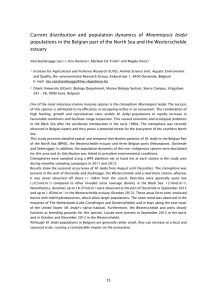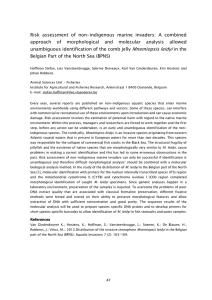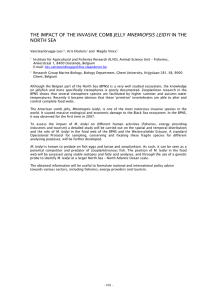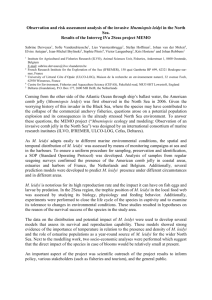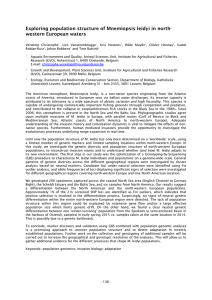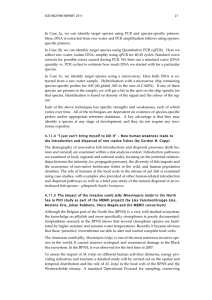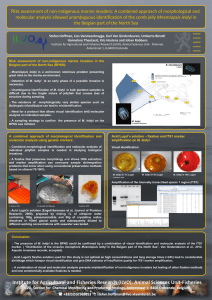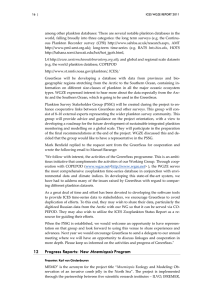Mnemiopsis leidyi Netherlands: an unrecognized invasion? Marco A. Faasse and Keith M. Bayha
advertisement
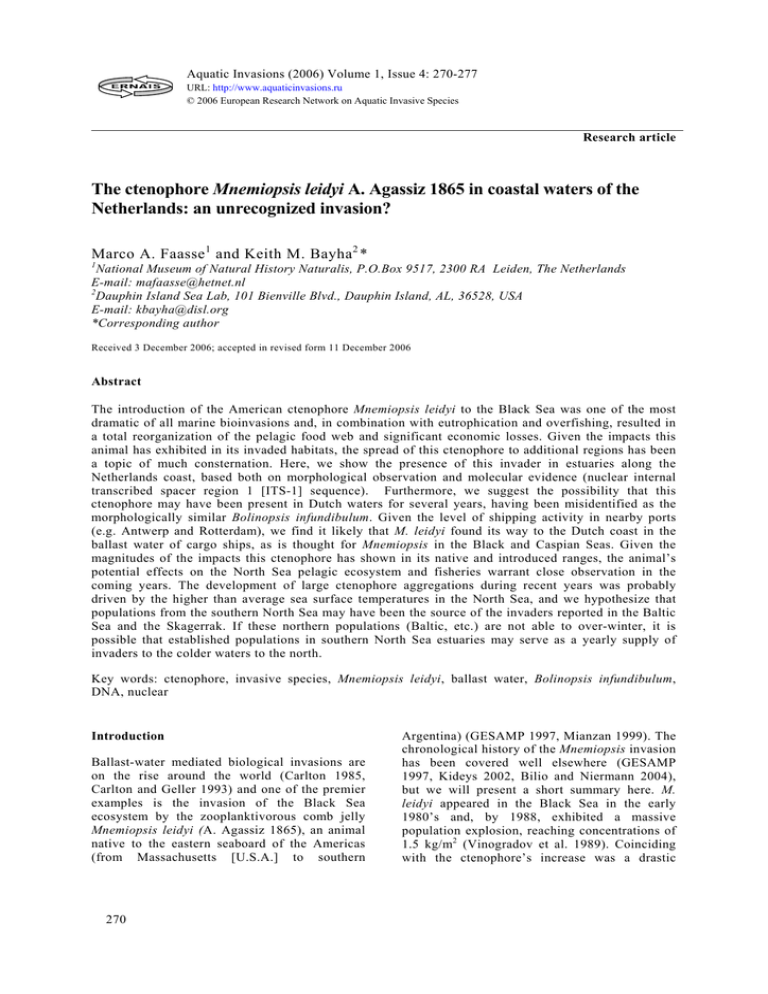
Aquatic Invasions (2006) Volume 1, Issue 4: 270-277 URL: http://www.aquaticinvasions.ru © 2006 European Research Network on Aquatic Invasive Species Research article The ctenophore Mnemiopsis leidyi A. Agassiz 1865 in coastal waters of the Netherlands: an unrecognized invasion? Marco A. Faasse 1 and Keith M. Bayha 2 * 1 National Museum of Natural History Naturalis, P.O.Box 9517, 2300 RA Leiden, The Netherlands E-mail: mafaasse@hetnet.nl 2 Dauphin Island Sea Lab, 101 Bienville Blvd., Dauphin Island, AL, 36528, USA E-mail: kbayha@disl.org *Corresponding author Received 3 December 2006; accepted in revised form 11 December 2006 Abstract The introduction of the American ctenophore Mnemiopsis leidyi to the Black Sea was one of the most dramatic of all marine bioinvasions and, in combination with eutrophication and overfishing, resulted in a total reorganization of the pelagic food web and significant economic losses. Given the impacts this animal has exhibited in its invaded habitats, the spread of this ctenophore to additional regions has been a topic of much consternation. Here, we show the presence of this invader in estuaries along the Netherlands coast, based both on morphological observation and molecular evidence (nuclear internal transcribed spacer region 1 [ITS-1] sequence). Furthermore, we suggest the possibility that this ctenophore may have been present in Dutch waters for several years, having been misidentified as the morphologically similar Bolinopsis infundibulum. Given the level of shipping activity in nearby ports (e.g. Antwerp and Rotterdam), we find it likely that M. leidyi found its way to the Dutch coast in the ballast water of cargo ships, as is thought for Mnemiopsis in the Black and Caspian Seas. Given the magnitudes of the impacts this ctenophore has shown in its native and introduced ranges, the animal’s potential effects on the North Sea pelagic ecosystem and fisheries warrant close observation in the coming years. The development of large ctenophore aggregations during recent years was probably driven by the higher than average sea surface temperatures in the North Sea, and we hypothesize that populations from the southern North Sea may have been the source of the invaders reported in the Baltic Sea and the Skagerrak. If these northern populations (Baltic, etc.) are not able to over-winter, it is possible that established populations in southern North Sea estuaries may serve as a yearly supply of invaders to the colder waters to the north. Key words: ctenophore, invasive species, Mnemiopsis leidyi, ballast water, Bolinopsis infundibulum, DNA, nuclear Introduction Ballast-water mediated biological invasions are on the rise around the world (Carlton 1985, Carlton and Geller 1993) and one of the premier examples is the invasion of the Black Sea ecosystem by the zooplanktivorous comb jelly Mnemiopsis leidyi (A. Agassiz 1865), an animal native to the eastern seaboard of the Americas (from Massachusetts [U.S.A.] to southern 270 Argentina) (GESAMP 1997, Mianzan 1999). The chronological history of the Mnemiopsis invasion has been covered well elsewhere (GESAMP 1997, Kideys 2002, Bilio and Niermann 2004), but we will present a short summary here. M. leidyi appeared in the Black Sea in the early 1980’s and, by 1988, exhibited a massive population explosion, reaching concentrations of 1.5 kg/m2 (Vinogradov et al. 1989). Coinciding with the ctenophore’s increase was a drastic M. A. Faasse and K.M. Bayha, Mnemiopsis leidyi in the Netherlands reduction in the stocks of zooplankton species fed on by Mnemiopsis (Vinogradov and Shushkina 1992) and a subsequent crash in the landings of the Black Sea’s major fishery, that of the zooplanktivorous anchovy Engraulis encrasicolus (GFCM 1993 as referenced in Kideys 1994), with estimated losses in the hundreds of millions of U.S. dollars (Knowler 2005). While there is some discussion about the absolute role of Mnemiopsis in the anchovy collapse (Bilio and Niermann 2004), it was believed that the ctenophore affected fish stocks by feeding on fish eggs and larvae and by diminishing their food supplies (Kideys 1994). Mnemiopsis later spread from the Black Sea into the Sea of Azov (Vinogradov et al. 1989), the Sea of Marmara (Shiganova 1993), the Aegean Sea (Kideys and Niermann 1994), the Eastern Mediterranean Sea (Kideys and Niermann 1993) and finally the Caspian Sea (Ivanov et al. 2000). Similar ecological and economic impacts have followed the ctenophore’s invasion of the Caspian Sea (summarized in Kideys 2002 and Stone 2005). Given the vast ecological and economic impacts the M. leidyi invasion had in its invaded habitats, the possible appearance of this ctenophore elsewhere in the world has been a topic of major concern. Bolinopsis infundibulum (O. F. Müller, 1776), the dominant lobate ctenophore in the North Sea, is a typically cold-water species that was not commonly recorded in the warmer waters of the Dutch coast prior to 1992 (Greve 1975, Hayward and Ryland 1995). However, recent mass occurrences of B. infundibulum in the latesummer coastal waters of the Netherlands have raised concerns that a new invasion of the morphologically similar Mnemiopsis leidyi might have been involved. Beginning in 1992, B. infundibulum was reported in increasing numbers during the summer months in several estuaries along the Netherlands coast, including the Wadden Sea in the north and various estuaries in the southwest (Grevelingen and Oosterschelde) (Holsteijn 2002). There were two records in 1992 (Holsteijn 2002, M.A. Faasse pers. obs.), two in 2000, one in 2001 and numerous reports from 2002 onwards (Holsteijn 2002). In 2002, B. infundibulum was found to be so common by late June onwards, that Holsteijn (2002) stopped listing records, a fact not recorded in other years. These findings were puzzling, since one would not expect to find blooms of a typically coldwater ctenophore in the productive late summer waters of the Dutch estuaries. Earlier this year, between August and November of 2006, lobate ctenophores were found in visibly larger aggregations than ever before in several Netherlands estuarine regions (the Grevelingen, Oosterschelde, Westerschelde and the Wadden Sea). In order to definitively identify these ubiquitous lobate ctenophores, we collected animals from two different estuarine regions along the Dutch coast for species-level analyses based both on morphology and genetics. Here we confirm that the large blooms observed this summer in Dutch estuarine regions were, in fact, formed by the ctenophore Mnemiopsis leidyi and indicate that it is possible that this ctenophore may have been present in Dutch waters for several years. Materials and Methods Ctenophore sampling A total of 86 lobate ctenophores were collected between August and November of 2006 from two different estuarine regions along the Dutch coast: the Wadden Sea in the north and three different regions within the southwestern estuaries (the Grevelingen, the Oosterschelde and the Westerschelde) (Figure 1; Annex). Animals were collected in glass jars by SCUBA divers at depths of 5 – 15 meters and at the surface near Borssele and the Balgzand. Animals were then transferred to the lab for morphological identification. In some cases, ctenophores were preserved in 75–100% ethanol for later molecular identification. Morphological species identification In the lab, animals were observed in order to identify morphological characters delineating Bolinopsis infundibulum from Mnemiopsis leidyi, with small ctenophores observed under a dissecting microscope. The main morphological character delineating B. infundibulum from M. leidyi is the extent of the animal’s oral lobes. In B. infundibulum, the oral lobes terminate between the mouth and apical sense organ (Figure 2A), while in M. leidyi, the oral lobes terminate near the apical sense organ (statocyst) and span nearly the entire length of the body (Mayer 1912, Mianzan 1999) (Figure 2B). The extent of the oral lobes was recorded for each animal. 271 M. A. Faasse and K.M. Bayha, Mnemiopsis leidyi in the Netherlands Figure 1: A) Map of the North Sea coastal region B) Map of the Netherlands coast showing areas sampled for lobate ctenophores in this study, including sampling sites in the Wadden Sea (Balgzand), the North Sea (Spuisluis Brouwersdam and Vluchthaven Neeltje Jans), the Grevelingen (Scharendijke and Den Osse), the Oosterschelde (Anna Frisopolder, Goesse Sas, Bergsediepsluis and Zierikzee) and the Westerschelde (Borssele). Sites where ctenophores were collected and identified morphologically are labeled with grey circles and both morphologically and genetically are labeled with black circles. Figure 2: Photographs of A) Bolinopsis infundibulum B) Mnemiopsis leidyi and C) lobate ctenophore (M. leidyi) taken from Bommenede in the Grevelingen (02.09.2006). Note the termination of the oral lobes (1) and the placement of the statocyst (2). In M. leidyi, the oral lobes extend all the way to the statocyst, while they terminate near the mouth in B. infundibulum (B. infundibulum photograph (A) courtesy of G. R. Harbison [Woods Hole Oceanographic Institute], M. leidyi photograph (B) by K.M. Bayha and Bommenede M. leidyi photograph (C) by P.H. van Bragt). 272 M. A. Faasse and K.M. Bayha, Mnemiopsis leidyi in the Netherlands Molecular species identification Molecular species identification was performed using sequence data from the nuclear internal transcribed spacer region 1 (ITS-1). This region has been shown to be extremely useful in delineating species in a variety of organisms (Anderson and Adlard 1994, Dawson and Jacobs 2001, Schroth et al. 2002), including ctenophores (Podar et al. 2001, Bayha et al. 2004) and is easily amplified in comb jellies. For lobate ctenophores collected in Dutch waters, 3 animals were sequenced (two ctenophores from Den Osse in the Grevelingen and one from the Balgzand in the Wadden Sea [Figure 1; Annex]). DNA extraction, PCR amplification and DNA sequencing of the ITS-1 region was performed as in Bayha et al. (2004), with PCR amplification performed using the primers ITS1A (5’GGTTTCTGTAGGTGAACCTGC-3’) and N73 (5’-GGCTCAGACAGACATGCTCC-3’) (Gaffney, unpublished). In addition, two Bolinopsis infundibulum individuals collected from the Northwest Atlantic (near N 38.53 W 70.60) were sequenced for ITS-1 in an identical manner. All DNA sequences were assembled using SeqMan II (DNAStar, Inc.) and electropherograms were checked by eye for poor base calls and sequence quality. Sequence identity was evaluated by performing BLASTN searches against GenBank (Altschul et al. 1997). In addition, DNA sequences were aligned against B. infundibulum sequence generated for this study and U.S. Atlantic Mnemiopsis leidyi (NCBI Accession # AF293700) ITS-1 sequence from NCBI GenBank using CLUSTALW (Thompson et al. 1994) in MegAlign (DNAStar, Inc.). Sequence divergence values (uncorrected p) were calculated in PAUP 4.0b10 (Swofford 2002). Results Between August and November 2006, lobate ctenophores were seen in the two different estuarine regions along the Dutch coast, in the Wadden Sea in the north and the southwestern estuaries (the Grevelingen, Oosterschelde and Westerschelde) (Figure 1; Annex), oftentimes in extremely large aggregations (Figure 3). Figure 3: Underwater photo of a Mnemiopsis leidyi bloom near Bommenede in the Grevelingen (26.08.2006). Photo courtesy of A. Rijsdijk. All 86 ctenophores collected from the four different water bodies (Annex) morphologically resembled Mnemiopsis leidyi. Ctenophores collected in August and September were found in 19 - 23 oC water, while those collected in October and November were found at temperatures down to 10 oC. Collected animals were between 1.5 and 8 cm in length, with the majority falling within 4 – 6 cm. A typical picture of one of the invasive ctenophores can be seen in Figure 2C. In all ctenophores, the animals’ oral lobes terminated even with the animal’s apical sense organ, as in M. leidyi (Figure 2B), the main character that differentiates it from B. infundibulum (Figure 2A). ITS-1 sequences for all animals sequenced (two ctenophores from Den Osse in the Grevelingen and one from the Balgzand in the Wadden Sea [Figure 1; Annex]) were 233 base pairs long and identical to one another. Both Bolinopsis infundibulum ITS-1 sequences were 228 base pairs long and differed from each other by a single base at a degenerate site (T in one individual and Y [C and T] in the other). All ITS-1 sequences from Netherlands ctenophores were nearly indistinguishable from published Mnemiopsis leidyi sequence, differing by a single base (T in our specimens and Y [C and T] in the published sequence). In contrast, the Netherlands ctenophore ITS-1 sequences differed from those of Bolinopsis infundibulum by 11.5%. The identical M. leidyi sequences were deposited in the NCBI Genbank database under the accession number EF175463, while the two B. infundibulum sequences were deposited under the accession numbers EF175464 and EF175465. 273 M. A. Faasse and K.M. Bayha, Mnemiopsis leidyi in the Netherlands Discussion These morphological and molecular analyses mark the first confirmed report of Mnemiopsis leidyi in the North Sea and among the first reports outside of the animal’s native range or the Mediterranean-Black-Caspian Seas (see Sai Sastry and Chandramohan 1989). Furthermore, it is possible that M. leidyi has actually been present in Dutch estuaries several years, as some of the late summer 2002 reports of B. infundibulum by Holsteijn (2002) may actually have been misidentifications of M. leidyi. The superficial morphological similarity of the two species (Figure 2) could easily result in misidentification, especially by those not familiar with M. leidyi or ctenophores in general. In addition, it is curious that Holsteijn (2002) recorded large numbers of the boreal B. infundibulum in warm, productive late-summer estuarine waters, waters that would be much more amenable to M. leidyi (Kremer 1994, Purcell et al. 2001). So, while this is far from definitive, it is possible that Mnemiopsis has been present in Dutch estuaries for some time, slowly increasing its population size over the years, much like the ctenophore did in the Black Sea between its initial sighting in the early 1980’s and its population explosion in 1988 (Vinogradov et al. 1989). Ballast water transfer is well known as a major vector for the worldwide transport of invasive species (Carlton 1985, Carlton and Geller 1993). Two of the largest European ports, Antwerp and Rotterdam, are very geographically close to the southwestern estuarine region of the Netherlands (Grevelingen, Oosterschelde and Westerschelde). The amount of ballast water discharge in Dutch ports alone is estimated at 7.5 million tonnes/year (Aquasense 1998 as referenced in Wetsteyn and Vink 2001). The North Sea has received a large number of invading organisms (Reise et al. 1999, Wolff 2005) and it is estimated that the North Sea is the second-most invaded water body in Europe, behind the Mediterranean Sea, based both on total number of invaders, as well as those distributed by shipping (Gollasch 2006). Given the amount of ballast water transported to Dutch ports, as well as the proximity to the invaded areas, it is likely that Mnemiopsis leidyi arrived in Dutch waters as a result of ballast water transfer, much as it has been assumed of its invasions of the Black and Caspian Seas 274 (Vinogradov et al. 1989, Ivanov et al. 2000), though the specific source region is unclear at this time. The presence of M. leidyi in northern Europe is an alarming development and it is essential that effects on the environment be closely monitored. Patterns seen in the Black Sea might be replicated in northern Europe, with impacts on zooplankton species and their predators. Two of the most important fisheries in North Sea waters are for the plaice (Pleuronectes platessa) and sole (Solea solea), whose annual combined catch amounts to EUR 300 million (European Commission 2006). Mnemiopsis might impact fish stocks by preying on eggs and larvae, as the ctenophore Pleurobrachia pileus does on both species (Lebour 1923, Greve 1975) and by competing with larvae for food, as there is dietary overlap between M. leidyi and both fish species (Last 1978). This is especially important for the Dutch coast, since Dutch estuaries and coastal waters serve as nursery habitats for both sole and plaice (van Beek et al. 1989). Furthermore, it is unclear if any species will feed heavily on Mnemiopsis within Dutch waters. Typically, only Beroe gracilis, a ctenophore predator that feeds on Pleurobrachia pileus, occurs in Dutch estuaries in great numbers (Gmelig Meyling et al. 1999), and given its small size in relation to Mnemiopsis, it remains to be seen whether or not it will efficiently feed on M. leidyi. Perhaps in the future, the area may experience an invasion of the Mnemiopsis predator Beroe ovata sensu Mayer from the western Atlantic, which may help control M. leidyi populations, as it did in parts of the Black Sea (Finenko et al. 2003). Also worrisome is the possibility of M. leidyi spreading to adjacent water bodies and establishing persisting populations, especially in semi-enclosed water bodies, such as the Baltic Sea, where ctenophore impact might be more severe. North Sea surface temperatures have increased steadily in the past decades and recent temperatures (especially this past summer) have been some of the highest on record (Bundesamt für Seeschifffahrt und Hydrographie 2006). This may have been especially true in the shallower Dutch estuaries, as large parts of the Grevelingen had surface temperatures as high as 26 oC during July (Hydro Meteo Centrum Zeeland 2006). In its native range, water temperature is one of the dominant factors determining the level of population increase in Mnemiopsis (Kremer 1994). Therefore, it is likely that increasing M. A. Faasse and K.M. Bayha, Mnemiopsis leidyi in the Netherlands temperatures aided the earlier population establishment of M. leidyi in Dutch estuaries, as well as formation of the large blooms seen this summer. With the high shipping traffic in Dutch ports, ballast water transport may be an important vector for ctenophores leaving the Netherlands coast, resulting in further Mnemiopsis invasions elsewhere, especially as Mnemiopsis populations get larger in Dutch waters. The large M. leidyi populations in the southern North Sea may be the source population for recent ctenophore sightings in Swedish waters (the Skagerrak) (H. Hansson, pers. comm., see also Hansson 2006 – this issue) and within the Baltic Sea (Kiel Bight) (J. Javidpour and U. Sommer, pers. comm., see also Javidpour et al. 2006 in this issue). It is possible that the large populations of M. leidyi in the southern North Sea, driven by the higher than normal sea surface temperatures of recent years, may have served as a source of invaders of the Skagerrak, the Kattegat and the westernmost part of the Baltic Sea, either via the North Sea or, more likely, via the Kiel-Canal, a canal that extends from the Wadden Sea to the Kiel Bight. It is possible that Mnemiopsis has survived multiple winters in the southern North Sea estuaries, where winter temperatures average about 3 oC (sometimes falling to ~2oC), with higher temperature refuge areas at depth (Wolff 1973, Hydro Meteo Centrum Zeeland 2006). It remains to be seen whether or not the ctenophore will be capable of over-wintering in the more northern regions (Baltic Sea, etc.), where average winter temperatures tend to be colder (Bundesamt für Seeschifffahrt und Hydrographie 2006). If not, the southern North Sea and its estuaries may serve as a reservoir of M. leidyi and a yearly source of new immigrants each summer to these colder waters, similarly to the way in which the Sea of Azov must be reinvaded by Mnemiopsis each summer (Studenikina et al. 1991). It has been theorized that with global climate change, warm temperature organisms might be able to establish stable populations in waters that were previously too cold (Leppäkoski et al. 2002). This yearly inoculation of the Baltic Sea with new invaders could then result in persistent populations of M. leidyi should average sea surface temperatures continue to increase and these waters become more hospitable to Mnemiopsis introduction and establishment. Note added to proof A very recent article (Tulp 2006), published during our final proof preparation, morphologically identified Mnemiopsis leidyi in the Wadden Sea, near Den Helder (near our Balgzand station) and Lauwersoog. Acknowledgements We would like to acknowledge A.H.M. Ligthart for assistance with all of the fieldwork as well as her invaluable input during the initial morphological identifications of Mnemiopsis leidyi. We would like to thank R. Dekker (NIOZ, Texel, The Netherlands), P.H. van Bragt and E. Verstraete for help with ctenophore collection (Netherlands) as well as A. Moss, L.P. Madin, P. Kremer, E.H. Horgan and the crew of the R/V Oceanus for collection of Atlantic Bolinopsis infundibulum. The authors are also grateful to H. Hansson, J. Javidpour and U. Sommer for their willingness to provide information about the presence of Mnemiopsis in Swedish and German waters. M.A.Faasse would like to acknowledge R.M.L. Ates for his valuable discussions in 2002 regarding the possibility of a Mnemiopsis invasion. K.M. Bayha would like to recognize the support of W.M. Graham (in whose lab the molecular work was performed) and the Dauphin Island Sea Lab, as well as collaborations and communications with G.R. Harbison, P.M. Gaffney, and A.G. Marsh. The authors would like to acknowledge editorial suggestions by S. Gollasch, E. Demir and an anonymous reviewer. References Altschul SF, Madden TL, Schäffer AA, Zhang J, Zhang Z, Miller W and Lipman DJ (1997) Gapped BLAST and PSIBLAST: a new generation of protein database search programs. Nucleic Acids Research 25: 3389-3402 Anderson T and R Adlard (1994) Nucleotide sequence of a rDNA internal transcribed spacer supports synonymy of Saccostrea commercialis and S. glomerata. Journal of Molluscan Studies 60: 196-197 Aquasense (1998) Ballastwater. Overview of available data and estimation of possible risks. AquaSense, Amsterdam, report nr. 98.1162, 63 pp. Bayha KM, Harbison GR, McDonald JH and Gaffney PM (2004) Preliminary investigation on the molecular systematics of the invasive ctenophore Beroe ovata. In: Dumont H, Shiganova TA, Niermann U (eds.) Aquatic Invasions in the Black, Caspian and Mediterranean Seas, pp. 167 - 175. Kluwer Academic Publishers, Dordrecht. 275 M. A. Faasse and K.M. Bayha, Mnemiopsis leidyi in the Netherlands Beek FA van, Rijnsdorp AD and Clerck R de (1989) Monitoring juvenile stocks of flatfish in the Wadden Sea and the coastal areas of the southeastern North Sea. Helgoland Marine Research 43(3-4): 461-477 Bilio M and Niermann U (2004) Is the comb jelly really to blame for it all? Mnemiopsis leidyi and the ecological concerns about the Caspian Sea. Marine Ecology Progress Series 269: 173-183 Bundesamt für Seeschifffahrt und Hydrographie (2006) Sea surface temperatures. http://www.bsh.de/en/Marine% 20data/Observations/Sea%20surface%20temperatures/inde x.jsp (accessed 3 December 2006) Carlton JT (1985) Transoceanic and interoceanic dispersal of coastal marine organisms: the biology of ballast water. Oceanography and Marine Biology Annual Review 23: 313-374 Carlton JT and Geller JB (1993) Ecological roulette: The global transport of nonindigenous marine organisms. Science 261: 78-82 Dawson MN and DK Jacobs (2001) Molecular evidence for cryptic species of Aurelia aurita (Cnidaria, Scyphozoa). Biological Bulletin 200: 92-96 European Commission (2006) Proposal for a Council Regulation establishing a management plan for fisheries exploiting stocks of plaice and sole in the North Sea. Brussels, 10/1/2006 Finenko GA, Romanova ZA, Abolmasova GI, Anninsky BE, Svetlichny LS, Hubareva ES, Bat L and Kideys AE (2003) Population dynamics, ingestion, growth, and reproduction rates of the invader Beroe ovata and its impact on plankton community in Sevastopol Bay, Black Sea. Journal of Plankton Research 25: 539-549 GESAMP (IMO/FAO/UNESCO-IOC/WMO/WHOI/IAEA/UN /UNEP Joint Group of Experts on the Scientific Aspects of Marine Pollution) (1997) Opportunistic settlers and the problem of the ctenophore Mnemiopsis leidyi invasion in the Black Sea. GESAMP reports and studies No. 58. International Maritime Organization, London. GFCM (1993) Statistical Bulletin No. 9, nominal catches 1979 – 1991. FAO Bulletin Fishery Statistics, Rome. Gmelig Meyling A, de Bruyne RH, Gittenberger A and Schrieken N (1999) Het duiken gebruiken. Gegevensanalyse van fauna-onderzoek met sportduikers in de Zeeuwse kustwateren (Monitoringproject Onderwater Oever). Seizoenspatronen, trends en verspreiding van 117 mariene organismen. Report Stichting Anemoon, Bennebroek (in Dutch) Gollasch S (2006) Overview on introduced aquatic species in European navigational and adjacent waters. Helgoland Marine Research 60: 84–89 Greve W (1975) Phylum Ctenophora. Fiches Identification Zooplancton 146: 1-6 Hansson HG (2006) Ctenophores of the Baltic and adjacent Seas – the invader Mnemiopsis is here! Aquatic Invasions 1(4): 295-298 Hayward PJ and Ryland SJ (1995) Handbook of the marine fauna of North West Europe. Oxford University Press, New York. Holsteijn H (2002) Toch nog een beetje nieuw: Bolinopsis infundibulum (Müller, 1776) en Beroe cucumis (Fabricius, 1780) aan onze kust. Het Zeepaard 62(5): 142-150 (in Dutch) 276 Hydro Meteo Centrum Zeeland (2006) Waterkwaliteit Grevelingenmeer. Rijkswaterstaat Direktie Zeeland. http://www.hmcz.nl (accessed 8 December 2006) Javidpour J, Sommer U and Shiganova T (2006) First record of Mnemiopsis leidyi A. Agassiz 1865 in the Baltic Sea. Aquatic Invasions 1(4): 299-302 Ivanov VP, Kamakin AM, Ushivtsev VB, Shiganova TA, Zhukova OP, Aladin N, Wilson SI, Harbison GR and Dumont HJ (2000) Invasion of the Caspian Sea by the comb jellyfish Mnemiopsis leidyi (Ctenophora). Biological Invasions 2: 255-258 Kideys AE (1994) Recent dramatic changes in the Black Sea ecosystem: the reason for the sharp decline in Turkish anchovy fisheries. Journal of Marine Systems 5: 171-181 Kideys AE (2002) Fall and rise of the Black Sea ecosystem. Science 297: 1482-1483 Kideys AE and Niermann U (1993) Intrusion of Mnemiopsis mccradyi (Ctenophora; Lobata) into the Mediterranean Sea. Senckenbergiana Maritima 23: 43-47 Kideys AE and Niermann U (1994) Occurrence of Mnemiopsis along the Turkish coasts (from northeastern Mediterranean to Istanbul). ICES Journal of Marine Science 51: 423-427 Knowler D (2005) Reassessing the costs of biological invasion: Mnemiopsis leidyi in the Black Sea. Ecological Economics 2: 187-199 Kremer P (1994) Patterns of abundance for Mnemiopsis in US coastal waters – A comparative review. ICES Journal of Marine Science 51: 347-354 Last JM (1978) The food of four species of pleuronectiform larvae in the eastern English channel and southern North Sea. Marine Biology 45: 359-368 Lebour MV (1923) The food of plankton organisms. II. Journal of the Marine Biological Association of the U.K. 13: 70-92 Leppäkoski E, Gollasch S, Gruszka P, Ojaveer H, Olenin S. and Panov V (2002) The Baltic – a sea of invaders. Canadian Journal of Fisheries and Aquatic Sciences 59: 1175-1188 Mayer AG (1912) Ctenophores of the Atlantic Coast of North America. Carnegie Institute Publishing, Washington Mianzan HW (1999) Ctenophora. In: Boltovskoy D. (ed.), South Atlantic Zooplankton. Backhuys, Leiden, The Netherlands, pp. 561–573 Podar M, Haddock SHD, Sogin ML and Harbison GR (2001) A molecular genetic framework for the phylum Ctenophora using 18s rRNA genes. Molecular Phylogenetics and Evolution 21: 218-230 Purcell JE, Shiganova TA, Decker MB and Houde ED (2001) The ctenophore Mnemiopsis in native and exotic habitats: U.S. estuaries versus the Black Sea basin. Hydrobiologia 451: 145-176 Reise KS, Gollasch S and Wolff WJ (1999) Introduced marine species of North Sea coasts. Helgoländer Meeresuntersuchungen 52: 219-234 Sai Sastry AGR and P Chandramohan (1989) Planktonic coelenterates of Vasishta Godavari estuary, east coast of India. Indian Journal of Marine Sciences 18: 160-164 Schroth W, Jarms G, Streit B, Schierwater B (2002) Speciation and phylogeography in the cosmopolitan marine moon jelly, Aurelia sp. BMC Evolutionary Biology 2: 1 M. A. Faasse and K.M. Bayha, Mnemiopsis leidyi in the Netherlands Shiganova TA (1993) Ctenophore Mnemiopsis leidyi and ichthyoplankton in the Sea of Marmara in October of 1992. Oceanology 33: 900-903 Stone R (2005) Attack of the killer jellies. Science 309: 1805-1806 Studenikina YeI, Volovik SP, Mirzoyan IA and Luts GI (1991) The ctenophore Mnemiopsis leidyi in the Sea of Azov. Oceanology 31: 722-725 Swofford DL (2002) PAUP*: Phylogenetic Analysis Using Parsimony (*and Other Methods). Version 4. Sinauer Associates, Sunderland Thompson JD, Higgins DG and Gibson TJ (1994) CLUSTAL W: improving the sensitivity of progressive multiple sequence alignment through sequence weighting, position specific gap penalties and weight matrix code. Nucleic Acids Research 22: 4673-4680 Tulp AS (2006) Mnemiopsis leidyi (Agassiz, 1865) (Ctenophora, Lobata) in de Waddenzee. Het Zeepaard 66: 183-189. Vinogradov ME, Shushkina EA, Musayeva EI, and Sorokin PY (1989) A newly acclimated species in the Black Sea: the ctenophore Mnemiopsis leidyi (Ctenophora: Lobata). Oceanology 29(2): 220-224 Vinogradov ME and Shushkina EA (1992) Temporal changes in community structure in the open Black Sea. Oceanology 32: 485-491 Wetsteyn LPMJ and Vink M (2001) Ballast water. An investigation into the presence of plankton organisms in the ballast water of ships arriving in Dutch ports, and the survival of these organisms in Dutch surface and port waters. Report RIKZ/2001.026. On behalf of the North Sea Directorate, Rijswijk Wolff WJ (1973) The estuary as a habitat. An analysis of data on the soft-bottom macrofauna of the estuarine area of the rivers Rhine, Meuse and Scheldt. Zoölogische Verhandelingen Leiden 126: 1-242 Wolff WJ (2005) Non-indigenous marine and estuarine species in The Netherlands. Zoölogische Mededelingen 79(1): 1-116 Annex Sampling sites where lobate ctenophores were collected for identification. * indicates samples were sequenced for ITS-1 to confirm species identification molecularly. + indicates regions located just outside the dam or storm barrier of the respective water body and, therefore, just inside the North Sea. Location coordinates Sampling Site Location (water body) Collection date Latitude, °N Number collected Longitude, °E Den Osse Grevelingen 51.7457 3.8868 01.07.2005 1 Den Osse* Grevelingen 51.7457 3.8868 11.08.2006 1 Den Osse Grevelingen 51.7457 3.8868 15.08.2006 10 Den Osse Grevelingen 51.7457 3.8868 21.08.2006 10 Den Osse* Grevelingen 51.7457 3.8868 02.09.2006 10 Balgzand* Wadden Sea 52.9820 4.9031 09.09.2006 4 Scharendijke Grevelingen 51.7411 3.8464 09.09.2006 10 51.7412 3.8104 09.09.2006 10 Spuisluis Brouwersdam North Sea + Goesse Sas Oosterschelde 51.5444 3.9279 30.09.2006 2 Anna Frisopolder Oosterschelde 51.6006 3.7007 21.10.2006 3 Zierikzee Oosterschelde 51.6292 3.9143 03.11.2006 10 51.6402 3.7001 11.11.2006 5 Vluchthaven Neeltje Jans North Sea Bergsediepsluis Oosterschelde 51.5159 4.1730 18.11.2006 5 Borssele Westerschelde 51.4264 3.7147 18.11.2006 5 + 277
